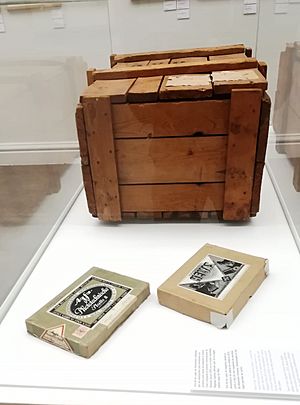Margaret Michaelis-Sachs facts for kids
Margaret Michaelis-Sachs (born in 1902, died in 1985) was an amazing photographer from Austria who later lived in Australia. She was of Polish-Jewish background. She took many portraits, but her most famous photos show the Spanish Civil War in Barcelona and other places. She also captured images of the Jewish quarter in Kraków in the 1930s, which are very important for history.
Contents
Early Life and Photography Training
Margaret was born on April 6, 1902, in a town called Dzieditz, which was then part of Austria-Hungary (now in southern Poland). Her father, Heinrich Gross, was a well-off Jewish doctor. From 1918 to 1921, she studied photography at a special school in Vienna, Austria.
Her Photography Journey
In 1922, Margaret started working at a photo studio in Vienna. She then worked at other studios in Vienna, Berlin, and Prague. In 1929, she returned to Berlin during a very tough time called the Great Depression, where many people lost their jobs. She worked for different studios during these hard years.
In October 1933, she married Rudolf Michaelis. Rudolf was part of a political group that believed in people organizing themselves without a strong government. Because of his beliefs, the Nazis quickly arrested and jailed him. After Rudolf was released in December 1933, the couple moved to Spain. However, they soon separated.
In Barcelona, Spain, Margaret opened her own photo studio called Foto-elis. She worked with architects, taking pictures of modern buildings. These photos were published in Spanish magazines. When the Spanish Civil War began, she also took pictures for a magazine called Nova Iberia.
After going back to Poland in 1937, she got a German passport. She then went to London and, in September 1939, moved to Australia. At first, she worked as a house maid in Sydney. In 1940, she opened her own "Photo-studio" in Sydney. She became one of the few women photographers there. She was known for her portraits, especially of people from Europe, Jewish people, and artists. Many of her photos were published in Australian magazines. She was also the only woman to join a group of photographic illustrators in 1941.
Margaret Michaelis stopped her photography work in 1952 because her eyesight became poor. In 1960, she married Albert George Sachs, who sold glass. She passed away on October 10, 1985, in Melbourne, Australia.
Her Unique Photography Style
When Margaret started her career, she used a modern photography style. This meant her photos were very clear and sometimes taken from unusual angles. Her portraits aimed to show the true feelings and personality of the people she photographed. She especially focused on capturing the lives of Jewish immigrants.
A very important collection of her photos shows scenes from the Jewish market in Kraków in the 1930s. A historian from the National Gallery of Australia said these pictures are very meaningful. They show a way of life that was later destroyed by fascism, a harsh political system.
Margaret also enjoyed taking pictures of herself, often using the beautiful landscapes around Sydney and Melbourne as backgrounds.
Her Lasting Impact
During the Spanish Civil War, Margaret used her Leica camera in Barcelona and other parts of Catalonia. She took photos for the public relations office of an anarchist group called CNT-FAI. Anarchists are people who believe in societies without a government, where people organize themselves freely. Her photos were used to help people feel strong and brave in their fight against the Spanish Fascist movement, which was a very strict and controlling political group.
When the civil war ended, her photographs and other documents were sent in wooden crates to a special history institute in Amsterdam. For 80 years, these photos were forgotten inside the crates. Then, a Spanish art historian named Almudena Rubio rediscovered them, along with photos by another photographer, Kati Horna. Most of these pictures had never been seen before. They were shown for the first time in an exhibition in Madrid in June 2022.
Margaret Michaelis's pictures show many things: street actions by anarchist fighters, everyday life in Barcelona and small Catalonian villages, and rare photos of important people like Emma Goldman. They also show the British Red Cross arriving at the border between France and Spain. Almudena Rubio said that Margaret's work is special because it shows the revolutionary experience of ordinary people during the war, which is often forgotten in official history books. Her photos help us understand the lives of these photographers during the war and how important their work was in fighting against fascism in Spain.
Exhibitions
- 1987: Retrospective, National Gallery of Australia
- 1998: Instituto Valenciano de Arte Moderno Centre Julio González, Valencia
- 2005: Retrospective, National Gallery of Australia
See also
 In Spanish: Margaret Michaelis-Sachs para niños
In Spanish: Margaret Michaelis-Sachs para niños


